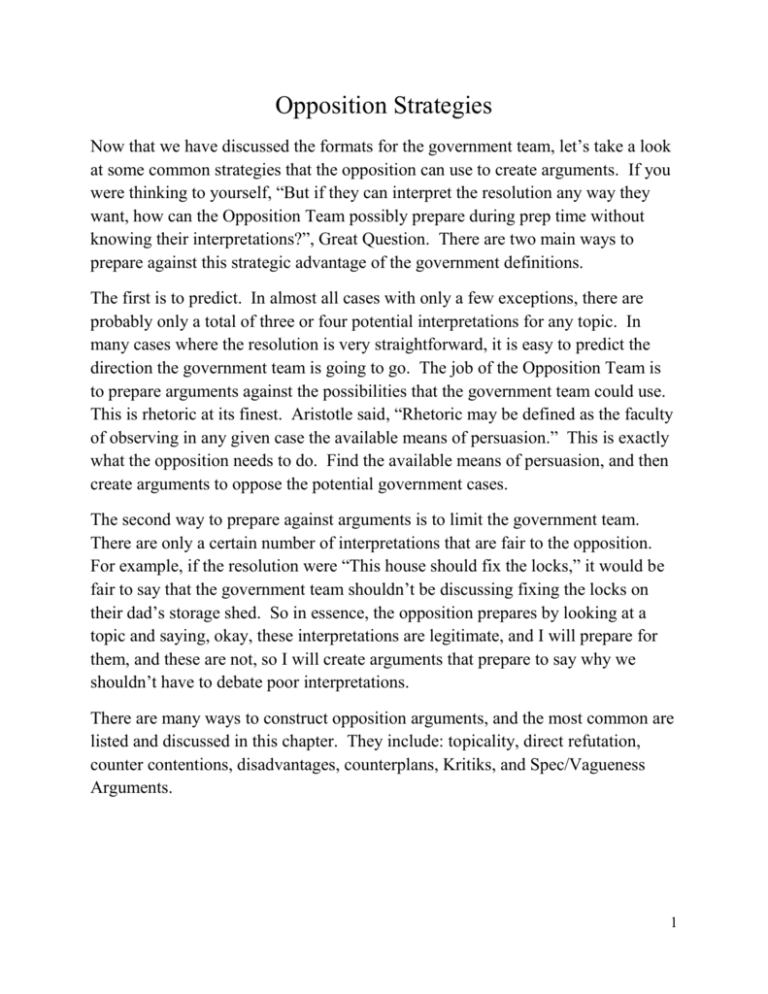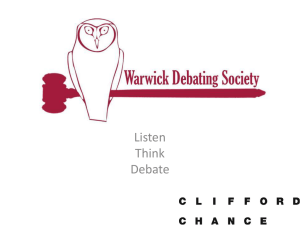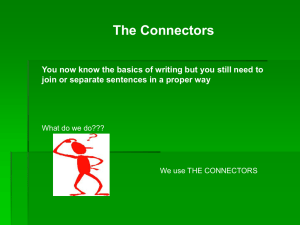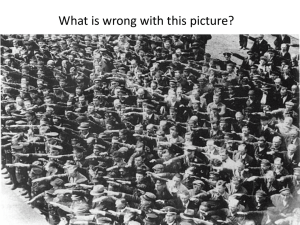Opposition Strategies
advertisement

Opposition Strategies Now that we have discussed the formats for the government team, let’s take a look at some common strategies that the opposition can use to create arguments. If you were thinking to yourself, “But if they can interpret the resolution any way they want, how can the Opposition Team possibly prepare during prep time without knowing their interpretations?”, Great Question. There are two main ways to prepare against this strategic advantage of the government definitions. The first is to predict. In almost all cases with only a few exceptions, there are probably only a total of three or four potential interpretations for any topic. In many cases where the resolution is very straightforward, it is easy to predict the direction the government team is going to go. The job of the Opposition Team is to prepare arguments against the possibilities that the government team could use. This is rhetoric at its finest. Aristotle said, “Rhetoric may be defined as the faculty of observing in any given case the available means of persuasion.” This is exactly what the opposition needs to do. Find the available means of persuasion, and then create arguments to oppose the potential government cases. The second way to prepare against arguments is to limit the government team. There are only a certain number of interpretations that are fair to the opposition. For example, if the resolution were “This house should fix the locks,” it would be fair to say that the government team shouldn’t be discussing fixing the locks on their dad’s storage shed. So in essence, the opposition prepares by looking at a topic and saying, okay, these interpretations are legitimate, and I will prepare for them, and these are not, so I will create arguments that prepare to say why we shouldn’t have to debate poor interpretations. There are many ways to construct opposition arguments, and the most common are listed and discussed in this chapter. They include: topicality, direct refutation, counter contentions, disadvantages, counterplans, Kritiks, and Spec/Vagueness Arguments. 1 Topicality Previously, resolutional analysis was discussed as a way for the government to define the topic. Debaters will often work with the resolution as a way to provide them a strategic advantage. In other words, if the government team can provide a legitimate interpretation that the Opposition Team is not ready for, they are more likely to win the debate. However, creative interpretations can sometimes be unrealistic and unfair for the Opposition Team to debate. If you are on the opposition side in a debate, and the government team defines the topic in a way that you feel is unfair, the correct way to respond is with a topicality argument. A topicality argument looks like this: Interpretation Violation Standards Voting Issue The INTERPRETATION portion simply says that this is what we believe that this word or these words would have been in order to be fair. Usually the reasons why your interpretation is best are discussed in the standards. The VIOLATION compares your interpretation to the definitions provided by the Government. In other words, you think it should be X; their interpretation was Y, so notice that X and Y are very different. The STANDARDS are arguably the most important portion of the topicality position. Basically what standards include are certain rules or concepts that people agree that fair definitions should contain. Field Context - Certain topic areas have jargon and specified language that are unique to their subject. The argument here is that the interpretation of the topic should be consistent with the language that individuals in that field are using. Fields with their own linguistic parameters such as science and academia are preferable because they provide clear context-specific definitions. 2 Literature - This standard looks at things that are published as a reason for an interpretation. For example, this was in the New York Times the last five days in a row, and no one is talking about your interpretation. The literature supports our interpretation. Ground - This standard argues that each side should have relatively equal access to arguments on each side. By defining the resolution in a way that is completely unpredictable and random, the Opposition Team is unable to prepare good arguments during prep time. Be sure to articulate ground loss by reading a portion of some of the arguments that are now irrelevant. Otherwise, the government team will accuse your team of unarticulated ground loss, or in other words, that you are making it up that you have great arguments that you can’t use. Common Usage - Man-On-The-Street interpretation. This standard argues that the most common interpretation is best, or at least that the way that the government team defined the resolution in inherently uncommon. Grammar - Since topics are generally read out loud, this is a very difficult standard to apply in parliamentary debate. The most common way it is used is when the topic specifically has a word that includes an “s,” which makes one or more of the definable terms plural. If the word should be plural and the government team defines it in a singular way, then they are not topical. Education - This is a fairly common standard although it is pretty bad. This can be run in conjunction with ground, if the opposition argues that the clash of arguments, meaning the head-to-head discussion of points, is the most educational activity possible. The loss of clash that has resulted due to the randomness of definitions has led to a loss in education. This standard is very challenging to win on because it is nearly impossible to define what is educational and what is not. Predictability - This standard usually should not be run alone, and commonly is run with ground. It basically says that there were only a few reasonable interpretations that the Opposition Team could predict to make the debate fair. The government team defined it in an unpredictable way, therefore it is not fair for the Opposition. 3 Framers Intent - This is probably the least effective of all commonly used topicality arguments. Debaters who use this standard explain that the person who created the topic believed that it was supposed to be interpreted in a certain way. There are a few reasons why this is a poor standard. First of all, if any of the debaters know the topics and their justifications beforehand, that is a form of cheating. Second, it doesn’t really matter what the framer intended. If it is vague and the rules allow for interpretation, then the original intent is irrelevant. The only time that this standard is reasonable is in tournaments that have certain topic areas. For example, Point Loma Nazarene University hosts a tournament that usually provides topic areas. One of the topic areas was drawn from Barack Obama’s inauguration speech. This was announced beforehand, therefore it is reasonable that the topic should be interpreted in a way that has something to do with US Federal Government policies and values. Brightline - Does our definition explain a topic to provide specific parameters from which the judge can understand topicality? For example, if the resolution is “This house should significantly reduce the number of inmates in federal prison,” and the government team defines significantly as “a major reduction,” then the Opposition Team has an opportunity to provide a better definition. Let’s say that the Opposition Team was able to cite in recent literature (using brightline in conjunction with the literature standard) and defined significantly as 20%. The Opposition Team would then argue that the government team is lowering the number of inmates less than 20% and are therefore not topical. On the government side, the definition is very vague, on the opposition side, the definition provides a clear delineation of what is significant and what is not. 20% is significant, 19% is not. Therefore the government team must lower the number of inmates by 20% or more. In cases like this, the brightline standard clarifies a government definition, while simultaneously illustrating how the government is not meeting the burden set forth by the better definition. The fourth component of topicality involves explaining to your judge why topicality is a VOTING ISSUE. Other arguments are weighted against each other, but the Opposition Team should argue that since definitions are the foundation for 4 all arguments and all potential cases, they should be considered first. This concept is known as a priori, literally translated as “from the former”. In other words, it comes before the case and is a foundational necessity to create a legitimate debate. Debaters should mention a priori in this section. Although a priori is not actually a voter, it should be discussed since it is a method of explanation as to why topicality should be its own independent reason to vote for the opposition. The most common voting issues include: Jurisdiction - The concept here is that the judge is responsible for voting on a case that has something to do with the resolution. If the government team is not arguing for a reasonable interpretation of the resolution, then the judge does not have the authority to vote for it. Since the judge is locked out of making a decision on the debate because of a violation committed by the government team, they are then obligated to vote for the Opposition Team. Fairness - This is probably the strongest argument to make as a voting issue in topicality. If the government team has constructed a case that is fundamentally unfair to the Opposition Team, then the judge is obligated to vote them down. Debaters agree that there should be at least some level of fairness when preparing for a case, and when the government team denies the Opposition Team reasonable arguments by defining them out of the round, it is the duty of the judge to vote against them. So if the judge believes the opposition has made a convincing argument that the definitions used by the government are unfair, then the government team should lose the debate based upon this fact. 5 Direct Refutation (aka On-Case/Four-Point Refutation) This type of argument on the opposition side is direct clash with the government. The format is as follows: 1. Identify the Argument: In their ________________________, they said: Here you are locating their argument and you are briefly recapping what they said. Remember not to linger too long here; your job is merely to show the judge exactly what argument you are responding to, not to re-argue the point for your opponent. 2. Preview your Argument: This section discusses what you are going to do. It often starts with “we are going to show that …” 3. Data and Reasoning: Here you are providing your counter argument. You can attempt this with a few different techniques, whether it is because it is not empirically proven, reasoning supports a different perspective, data contradicts your opponents point, or any other way that you think could be justification that their argument should not stand. This is also a great place to provide counter-examples that directly disprove the point made by your opponent. 4. Impact: The main idea here is to provide weight to your argument. You need to elaborate on why this point matters, both in the debate round and within the actual scenario being discussed. 6 For example, let’s say that the resolution was “Cats are better than dogs.” The Government Team has provided an argument that sounds something like this: Contention 1: Cats are the smartest animals around. They know when to conserve energy so that when they need to attack their prey, they have reserves to make sudden strikes. This allows them to feed their family and keep them safe. A response to this argument using Four-Point Refutation would look something like this: In their first contention, they discussed how cats are the smartest animals around because they can conserve energy. However, we disagree, and we will show you that the ability to conserve energy doesn’t necessarily make a creature smart. We believe that cats are lazy and do the minimal amount necessary just to survive. We believe that if cats used more energy, they could produce more and keep their families even safer. The impact here is that since cats conserve energy, it actually makes their families less safe because they could be using their energy in many other ways and don’t need to be conserving it. This structure works on both the government and the opposition side. It can be used to directly respond to ANY argument. While topicality and 4-point refutation can be applied to any type of resolution (fact, value, or policy), there are arguments that only should be used with specific topic interpretations. 7 Opposition Fact Cases Counter-Contentions Debaters who use this strategy are creating the same contentions that the government created, only on the other side of the issue. The format looks like this: Counter Contention #1 (1-3 word title) 1. Provide an example of something that opposes the resolution 2. Link - Specifically show how this relates to the opposition of the resolution Counter Contention #2 (1-3 word title) 1. Provide an example of something that opposes the resolution. 2. Link - Specifically show how this relates to the opposition of the resolution. Counter Contention #3 (1-3 word title) 1. Provide an example of something that opposes the resolution 2. Link - Specifically show how this relates to the opposition of the resolution. Does this look familiar? It should. Fact cases are very similar in their structure. The government is providing facts that illustrate examples of support for the resolution; the opposition is presenting facts that oppose the resolution. Notice that there is no resolutional analysis in this example, because it is not the burden of the Opposition Team to provide definitions. The only reasons that the opposition would want to discuss definitions is to raise a topicality argument or to simply agree and acknowledge them. The most common arguments in a fact case are 4-point refutation and countercontentions. The next most common argument would be topicality, followed by kritiks. We will discuss kritiks later on. 8 Opposition Value Cases Since the format of a government value case is usually very similar to a fact case, it makes sense that the opposition arguments are fairly similar as well. These arguments are also called counter-contentions. The format is as follows: Counter-Contention #1 1. Status quo illustrating an example that is counter to the resolution. 2. Link explaining how this example disproves the value 3. Impact that argues why this value is important in this scenario Counter-Contention #2 1. Status quo illustrating an example that is counter to the resolution. 2. Link explaining how this example disproves the value 3. Impact that argues why this value is important in this scenario Counter-Contention #3 1. Status quo illustrating an example that is counter to the resolution. 2. Link explaining how this example disproves the value 3. Impact that argues why this value is important in this scenario Remember, the values argued by the Government Team are usually not contestable, unless the opposition can somehow prove that they are not values at all. Because of this, these counter-contentions can be used against both formats presented in the government section. Also notice that in both fact and value counter-contentions, the examples only include three counter-contentions. This is because generally it is not necessary to prep too much more than this since the opposition still has the burden to respond to the contentions brought up by the Government Team. Even if the government argues three contentions, and the opposition argues three counter-contentions and responds to everything the government said, it is still challenging to get all of this in during an eight-minute speech. 9 Opposition Policy Cases The most common arguments presented in opposition policy cases are disadvantages. Basically a disadvantage explains the negative things that implementing the government plan will cause. The format is as follows: Disadvantage #1 (Brief 1-3 word title) 1. Status quo: Here you explain a situation that currently exists. 2. Link: This section discusses the fact that the plan will influence or change that situation 3. Internal Link: This section discusses how the change will lead to a changing of other important issues. 4. Impact: This section is generally considered the most important; it is where you discuss how this is going to be negative. This section is where you discuss who will be hurt, how badly, why that hurt is bad, and really explain the horrible things that will occur because of the government plan. Some students have trouble with the internal link section of this argument, and often times you will see this argument as follows: Disadvantage #1 (Brief 1-3 word title) 1. Status quo: Here you explain a situation that currently exists. 2. Link: This section discusses the fact that the plan will influence or change that situation 3. Impact: This section is where you discuss who will be hurt, how badly, why that hurt is bad, and really explain the horrible things that will occur because of the government plan. The main difference between the two is that the internal link describes in more detail how the plan will change the status quo. It is a deeper level of analysis than the second format, although the second format is often equally persuasive and easier to use. 10 There is another format that labels the status quo as the term “uniqueness”. The reasoning behind this is to illustrate that the situation discussed will be uniquely effected by the government plan, and it will not lead to the impacts without their specific advocacy. The format is as follows: 1. Uniqueness: Discuss a situation that will remain unchanged without the government plan. 2. Link: explain how the government plan will change the situation. 3. Internal Link: Discuss how this change will lead to changes in other important areas. 4. Impact: Elaborate on all of the negative consequences of these changes and show how they outweigh any of the potential benefits of the government plan. The above example includes the internal link, which may or may not be used, depending on the debater. It is smart to prepare as many disadvantages as possible in a policy case, and the depth of research that can tie the internal link to the plan is key to creating strong positions. Remember, the Opposition Team does not usually know the exact plan that will be argued by the Government Team, so there are usually disadvantages prepared on multiple potential interpretations. 11 Counterplans Some argue that one of the main goals of policy interpretations is to mirror the act of passing legislation to fix real world problems. If so, there are many ideas that need to be considered. What if this plan causes more problems than it fixes? What if there is a better solution? It makes sense that if there is a better solution to the problem, that solution should be preferred. This is what the opposition should do if they can come up with a better solution to solve for the problem. Consider this for a moment. California has a bill to legalize marijuana. The bill is kicked around for a few months, and it basically legalizes marijuana for everyone in the state because they say it is the only solution to solve for the state debt. There is another group who also supports the legalization of marijuana, but they believe that it should be legal only for people over 21. They cite the potential for abuse at an early age as being a horrible possibility for the original bill, so they propose a different solution that would still fix the original problem. This would be an example of a counterplan. Here are the main ideas: First, it needs to solve the problem better than the plan introduced by the government. Second, it should solve better than if the counterplan and plan were done at the same time. Third, it must have a specific text, with a mandate, agent, enforcement, and funding. Fourth, the plan must be competitive, meaning that it must force a choice between the plan and counterplan. There can be many reasons that a counterplan could be competitive. The most common reason is mutual exclusivity, meaning that it is logically impossible to do the counterplan and the plan at the same time. Another reason for competitiveness would look at the criterion, which is usually net benefits, and explain why the counterplan alone is better than the plan plus the counterplan. The reason that the example marijuana counterplan can’t be done in conjunction with the government plan is because the government plan specifies legality for everyone, while the opposition counterplan only allows for marijuana to be legal for individuals over 21. If it were to be done at the same time, it would involve language that made it both illegal and legal for individuals under 21. Either this makes no sense, or the government would have a host of issues on their hands by passing incoherent legislation. 12 The Difference Between Debate and Reality in this Example: Debate has certain rules in order to preserve fairness for both sides, and one of those is that the Government Team shouldn’t be able to change their original plan after it has been presented. In the above example, if there was a discussion and the only change to the original plan was to amend the age, both sides would probably agree and just change it in the original bill. However, since it wouldn’t be fair if the Government Team could just change their plan whenever they wanted, they have to stick to their original proposal of legality for everyone. Notice that this is a change to their original plan, not adding on something that could be done at the same time. 13



